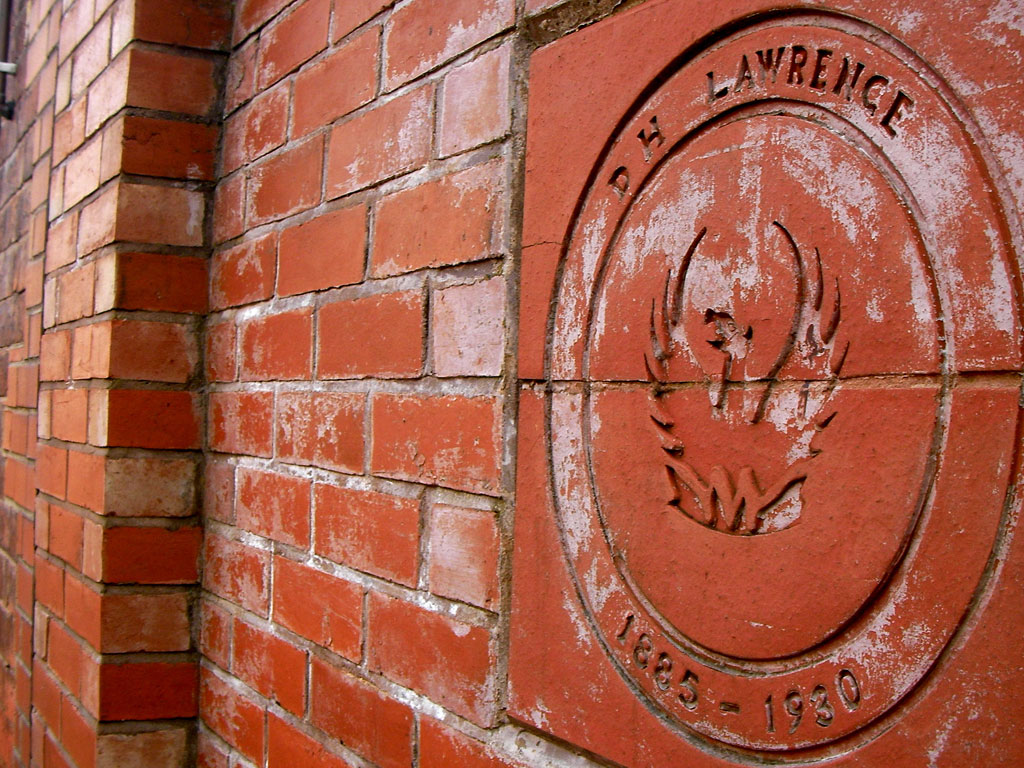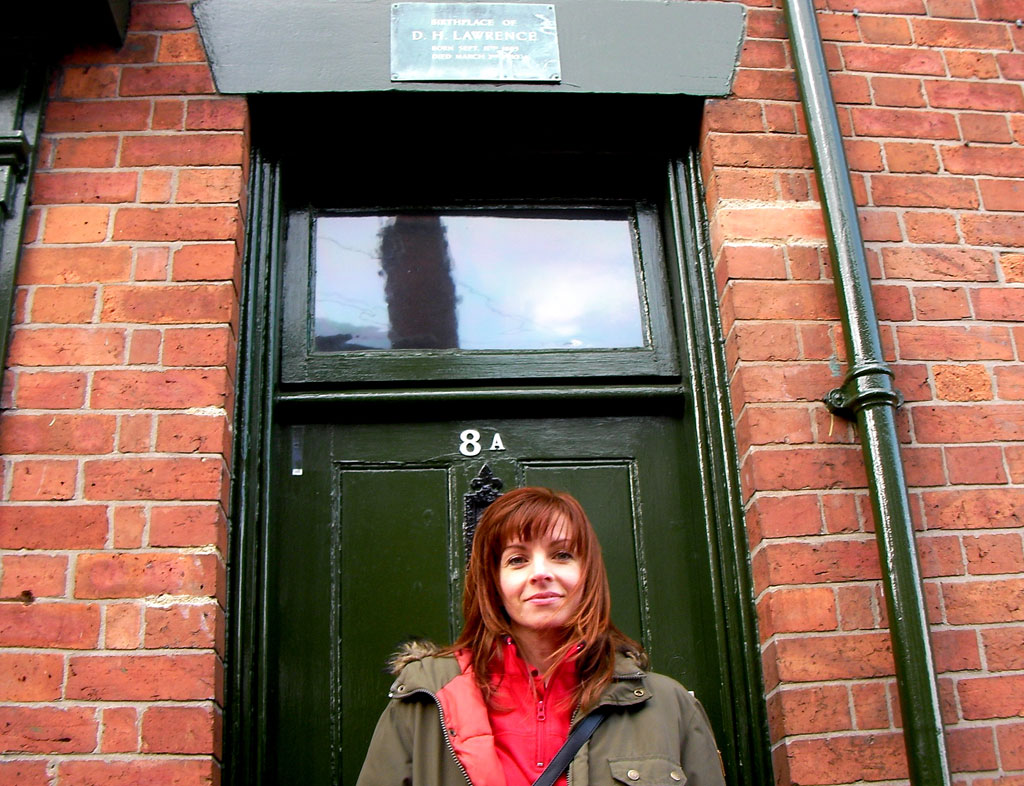* The tenth edition of the annual D.H. Lawrence Festival is currently under way in Eastwood, Lawrence’s home town in Nottinghamshire. It runs until September 21 with the The D.H. Lawrence Society’s Birthday Lecture on Wednesday this week. The next big literary story for me is the Dylan Thomas centenary in 2014 – more on that soon. Follow me on Twitter or subscribe to the RSS for more story updates.
The quiet in the reading room is almost tangible.
Librarians busy themselves filing rare first editions of novels, corrected proofs and crinkly old newspaper reviews. Students scrutinise leather-bound texts.
But, despite the hushed reverence of scholarly activity, there’s also a sense that deep passions are simmering beneath the surface – the subject of study is just that kind of author.
“I first read Sons & Lovers when I was 16 years old and found the way he expresses sexuality through nature to be totally different to any other writer,” says Annalise Grice, a PhD student at the University of Nottingham, researching the modernist writer D.H. Lawrence’s depiction of the new women genre. She adds:
“He’s a very sensual writer, not a sexual one.”
I meet Annalise while visiting the university’s D.H. Lawrence Research Centre and she takes me to see the Reading Room, where part of Lawrence’s prodigious output is held.
The university has been steadily building a collection of some 4,500 items since the mid 1950s. It plays a key role in the annual D.H. Lawrence Festival, staged in September in Eastwood, Nottinghamshire, and will contribute academic expertise to events this month to mark the centenary of the publication of Sons and Lovers.
For many, the image of D.H. Lawrence is summed up by the poet Philip Larkin, who wrote:
“Sexual intercourse began / In 1963 (which was rather late for me) / Between the Chatterley ban / And the Beatles’ first LP.”
This refers to Lawrence’s 1928 novel, Lady Chatterley’s Lover, which had been banned for obscenity.
The publishing house, Penguin, brought the test case for publication to the Old Bailey in 1960, where the prosecuting counsel, Mr Mervyn Griffith-Jones, famously asked the jury whether they considered Lawrence’s novel was something they would wish their wives or servants to read.
The trial marked a watershed in attitudes towards public decency and, when the ban was lifted, it became a best seller, ushering in a new age of sexual freedom in Britain.
Lawrence had become one of the most distinctive voices of the 20th century – not bad for a sickly miner’s son from working-class Nottinghamshire.
Early days
David Herbert Lawrence was born in the mining town of Eastwood on September 11, 1885, the fourth of five children to Arthur John Lawrence and his wife Lydia.
Ill health and a sensitive nature marked him as an outsider from a young age, caught between the marital tension of his social-climbing mother and hard-drinking father. These are themes he would return to many times in his career.
The young Lawrence was desperate to escape the mining town and gained a scholarship to study for his teacher’s certificate at University College, Nottingham from 1906 to 1908.
After a stint teaching in Croydon and bouts of ill health, he returned to Nottinghamshire in 1912 and a chance meeting changed the course of his life forever.
He went to see his old languages professor, Ernest Weekley, for advice and instead found the professor’s German wife, Frieda von Richthofen. The couple eloped soon afterwards, the women six years his elder causing a scandal by leaving her husband and young children behind.
They spent several itinerant years travelling, first to Munich and then to Gargnano, near Lake Garda, where Lawrence worked on Sons and Lovers, published the following May.
They made a brief return to England in 1919 before travelling extensively to Australia, Sri Lanka and New Mexico, Lawrence the struggling writer and Frieda the doting partner who claimed, “I love him with 1,000 different loves.”
The intensity of this relationship, and the Freudian relationship he had shared with his own mother, informed the sexual nature of his work. As Lawrence writes in Sons and Lovers:
“It was as if the pivot and pole of his life from which he could not escape, was his mother.”
For Andrew Harrison, Director of the D.H. Lawrence Research Centre, there is more to Lawrence’s work than the overt sexuality of Lady Chatterley’s Lover.
“I was in sixth form in Warwickshire when I first read some of his short stories, notably Odour of Chrysanthemums and You Touched Me. I felt an enormous sense of intimacy,” says Harrison. “Lawrence deals brilliantly with burgeoning sexuality and speaks to adolescents in a very tactile way.”
“People say Lawrence is a writer you grow out of and into Joyce. “To me, that’s moronic. I think he grows with you.”
Home town tour
From Nottingham, I pick up the trail at the D.H. Lawrence Heritage Centre in Eastwoo0d [pictured above].
This is the starting point for the Blue Line Trail, a one-hour walking route through residential streets, past terraced houses and local pubs, to places associated with his life story.
The walk takes in the Mechanics Institute, a Victorian lending library for working men where the young Lawrence would read, the Congregational Chapel where the family attended service and the Three Tuns pub, the favourite watering hole of Lawrence senior after a day’s work down the pit, which would turn up in Sons and Lovers as the Moon and Stars.
From the top of the hill on Lynncroft, and looking across the green space of the Canyons on Walker Street, the view extends to the mining villages beyond – Brinsley, Moorgreen and Annesley – where he documented the encroachment of industry on the Midlands landscape.
In Sons and Lovers he wrote:
“The hills were golden with evening; deep in the wood showed the darkening purple of bluebells. It was everywhere perfectly still, save for the rustling of leaves and birds.”
It’s 8a Victoria Street, the cramped miner’s cottage where he was born, that offers the greatest insight into Lawrence’s early life.
The cottage now houses the D.H. Lawrence Birthplace Museum and offers a glimpse of the tough conditions of Victorian mining communities. The gaslight burns in the front parlour, kept for Sunday best, and the fire glows in the hearth in the kitchen with its slop-stone sink and carbolic soap.
I can imagine the family sat around the kitchen table, his mother sewing, his father eating supper, and the young Lawrence drawing on the floor along side his siblings. Even the floral wallpaper in the children’s bedroom has been recreated to capture a snapshot of family in the Victorian era.
“What I admire about Lawrence is his attitude as a non-conformist and his ability to transcend his working-class roots,” explains Senior Heritage Assistant Carolyn Melbourne, as we walk through the family home from the adjoining exhibition about his life next door.
Lawrence always had an uneasy relationship with Eastwood and there was a lot of antipathy towards him locally for many years after his death, explains Carolyn. He often based his characters on real local people, barely changing their names, and locals said of him:
“E wor nowt b’r mardy bugger” (local dialect for being a moody character).
“Yet, today, he is a cult figure,” she adds. “He may be best known for his views on sexuality but, for me, it is his insight into ecology that makes him more relevant today than in any other previous generation.”
I finish the walk at the Heritage Centre, which puts Lawrence’s legacy into the broader social context of the East Midlands, and explores the impact of the Chatterley trial after his death. To this day Lawrence, it seems, stirs conflicting emotions.
On the blackboard in the recreation of the Victorian schoolroom, the chalk-dust graffiti reads: “D.H. Lawrence, I love and hate him. Liz, USA 2013.”
Exile years
Lawrence rarely returned to Britain after his self-imposed exile and died in Vance, Southern France, on Sunday March 2, 1930.
He was buried in the local cemetery and Frieda commissioned an elaborate gravestone, bearing a mosaic effigy of a phoenix, to mark his final resting place. This cane now be found at the Birthplace Museum in Eastwood.
Back at the D.H. Lawrence Research Centre, the students are dispersing and the librarians filing away the folios. Lawrence enthusiasts from around the world will converge on the centre (open to the public if you book and bring photo identification) and flock to Eastwood this month to celebrate Lawrence.
They will come to remember a man whose writing may have shocked the establishment, but it also managed to capture something of the emotions that stir within us all.
“It was the sheer intensity of his work that really spoke to me,” smiles Annalise Grice as we say our goodbyes.
“He says in one of his letter that he wanted to really dig down into the carbon when he writes. I feel that. It’s as if he’s writing what I am.”
* This story first appeared in Discover Britain magazine in August, 2013. A follow-up piece appeared on the National Geogrpahic Traveller blog. Read Nottinghamshire: the D. H. Lawrence Trail.
Liked this? Try also Reading up on D. H. Lawrence around Nottingham.
What do you think of these stories? Post your comments below.

